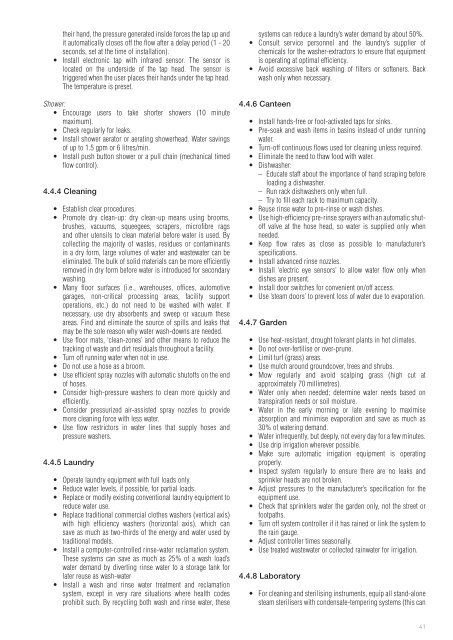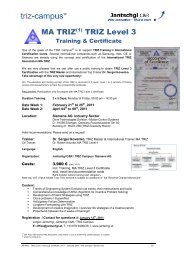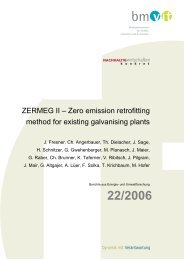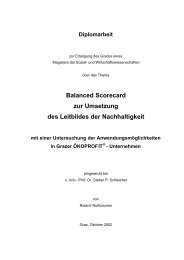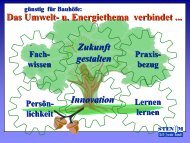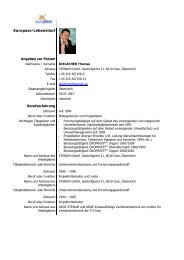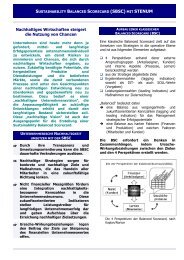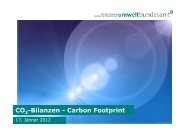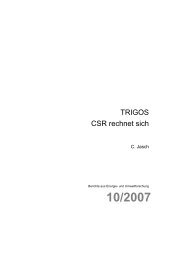Promoting Resource Efficiency in Small & Medium size ... - UNEP
Promoting Resource Efficiency in Small & Medium size ... - UNEP
Promoting Resource Efficiency in Small & Medium size ... - UNEP
Create successful ePaper yourself
Turn your PDF publications into a flip-book with our unique Google optimized e-Paper software.
their hand, the pressure generated <strong>in</strong>side forces the tap up and<br />
it automatically closes off the flow after a delay period (1 - 20<br />
seconds, set at the time of <strong>in</strong>stallation).<br />
• Install electronic tap with <strong>in</strong>frared sensor. The sensor is<br />
located on the underside of the tap head. The sensor is<br />
triggered when the user places their hands under the tap head.<br />
The temperature is preset.<br />
Shower:<br />
• Encourage users to take shorter showers (10 m<strong>in</strong>ute<br />
maximum).<br />
• Check regularly for leaks.<br />
• Install shower aerator or aerat<strong>in</strong>g showerhead. Water sav<strong>in</strong>gs<br />
of up to 1.5 gpm or 6 litres/m<strong>in</strong>.<br />
• Install push button shower or a pull cha<strong>in</strong> (mechanical timed<br />
flow control).<br />
4.4.4 Clean<strong>in</strong>g<br />
• Establish clear procedures.<br />
• Promote dry clean-up: dry clean-up means us<strong>in</strong>g brooms,<br />
brushes, vacuums, squeegees, scrapers, microfibre rags<br />
and other utensils to clean material before water is used. By<br />
collect<strong>in</strong>g the majority of wastes, residues or contam<strong>in</strong>ants<br />
<strong>in</strong> a dry form, large volumes of water and wastewater can be<br />
elim<strong>in</strong>ated. The bulk of solid materials can be more efficiently<br />
removed <strong>in</strong> dry form before water is <strong>in</strong>troduced for secondary<br />
wash<strong>in</strong>g.<br />
• Many floor surfaces (i.e., warehouses, offices, automotive<br />
garages, non-critical process<strong>in</strong>g areas, facility support<br />
operations, etc.) do not need to be washed with water. If<br />
necessary, use dry absorbents and sweep or vacuum these<br />
areas. F<strong>in</strong>d and elim<strong>in</strong>ate the source of spills and leaks that<br />
may be the sole reason why water wash-downs are needed.<br />
• Use floor mats, ‘clean-zones’ and other means to reduce the<br />
track<strong>in</strong>g of waste and dirt residuals throughout a facility.<br />
• Turn off runn<strong>in</strong>g water when not <strong>in</strong> use.<br />
• Do not use a hose as a broom.<br />
• Use efficient spray nozzles with automatic shutoffs on the end<br />
of hoses.<br />
• Consider high-pressure washers to clean more quickly and<br />
efficiently.<br />
• Consider pressurized air-assisted spray nozzles to provide<br />
more clean<strong>in</strong>g force with less water.<br />
• Use flow restrictors <strong>in</strong> water l<strong>in</strong>es that supply hoses and<br />
pressure washers.<br />
4.4.5 Laundry<br />
• Operate laundry equipment with full loads only.<br />
• Reduce water levels, if possible, for partial loads.<br />
• Replace or modify exist<strong>in</strong>g conventional laundry equipment to<br />
reduce water use.<br />
• Replace traditional commercial clothes washers (vertical axis)<br />
with high efficiency washers (horizontal axis), which can<br />
save as much as two-thirds of the energy and water used by<br />
traditional models.<br />
• Install a computer-controlled r<strong>in</strong>se-water reclamation system.<br />
These systems can save as much as 25% of a wash load’s<br />
water demand by divert<strong>in</strong>g r<strong>in</strong>se water to a storage tank for<br />
later reuse as wash-water<br />
• Install a wash and r<strong>in</strong>se water treatment and reclamation<br />
system, except <strong>in</strong> very rare situations where health codes<br />
prohibit such. By recycl<strong>in</strong>g both wash and r<strong>in</strong>se water, these<br />
systems can reduce a laundry’s water demand by about 50%.<br />
• Consult service personnel and the laundry’s supplier of<br />
chemicals for the washer-extractors to ensure that equipment<br />
is operat<strong>in</strong>g at optimal efficiency.<br />
• Avoid excessive back wash<strong>in</strong>g of filters or softeners. Back<br />
wash only when necessary.<br />
4.4.6 Canteen<br />
• Install hands-free or foot-activated taps for s<strong>in</strong>ks.<br />
• Pre-soak and wash items <strong>in</strong> bas<strong>in</strong>s <strong>in</strong>stead of under runn<strong>in</strong>g<br />
water.<br />
• Turn-off cont<strong>in</strong>uous flows used for clean<strong>in</strong>g unless required.<br />
• Elim<strong>in</strong>ate the need to thaw food with water.<br />
• Dishwasher:<br />
– Educate staff about the importance of hand scrap<strong>in</strong>g before<br />
load<strong>in</strong>g a dishwasher.<br />
– Run rack dishwashers only when full.<br />
– Try to fill each rack to maximum capacity.<br />
• Reuse r<strong>in</strong>se water to pre-r<strong>in</strong>se or wash dishes.<br />
• Use high-efficiency pre-r<strong>in</strong>se sprayers with an automatic shutoff<br />
valve at the hose head, so water is supplied only when<br />
needed.<br />
• Keep flow rates as close as possible to manufacturer’s<br />
specifications.<br />
• Install advanced r<strong>in</strong>se nozzles.<br />
• Install ‘electric eye sensors’ to allow water flow only when<br />
dishes are present.<br />
• Install door switches for convenient on/off access.<br />
• Use ’steam doors’ to prevent loss of water due to evaporation.<br />
4.4.7 Garden<br />
• Use heat-resistant, drought tolerant plants <strong>in</strong> hot climates.<br />
• Do not over-fertilise or over-prune.<br />
• Limit turf (grass) areas.<br />
• Use mulch around groundcover, trees and shrubs.<br />
• Mow regularly and avoid scalp<strong>in</strong>g grass (high cut at<br />
approximately 70 millimetres).<br />
• Water only when needed; determ<strong>in</strong>e water needs based on<br />
transpiration needs or soil moisture.<br />
• Water <strong>in</strong> the early morn<strong>in</strong>g or late even<strong>in</strong>g to maximise<br />
absorption and m<strong>in</strong>imise evaporation and save as much as<br />
30% of water<strong>in</strong>g demand.<br />
• Water <strong>in</strong>frequently, but deeply, not every day for a few m<strong>in</strong>utes.<br />
• Use drip irrigation wherever possible.<br />
• Make sure automatic irrigation equipment is operat<strong>in</strong>g<br />
properly.<br />
• Inspect system regularly to ensure there are no leaks and<br />
spr<strong>in</strong>kler heads are not broken.<br />
• Adjust pressures to the manufacturer’s specification for the<br />
equipment use.<br />
• Check that spr<strong>in</strong>klers water the garden only, not the street or<br />
footpaths.<br />
• Turn off system controller if it has ra<strong>in</strong>ed or l<strong>in</strong>k the system to<br />
the ra<strong>in</strong> gauge.<br />
• Adjust controller times seasonally.<br />
• Use treated wastewater or collected ra<strong>in</strong>water for irrigation.<br />
4.4.8 Laboratory<br />
• For clean<strong>in</strong>g and sterilis<strong>in</strong>g <strong>in</strong>struments, equip all stand-alone<br />
steam sterilisers with condensate-temper<strong>in</strong>g systems (this can<br />
41


